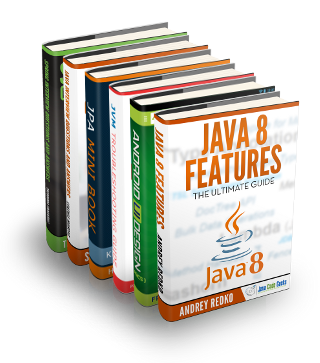Functional Java by Example | Part 8 – More Pure Functions
This is part 8, the last instalment of the series called “Functional Java by Example”.
The example I’m evolving in each part of the series is some kind of “feed handler” which processes documents. In the last instalment we’ve seen some pattern matching, using the Vavr library, and treated failures as data too, e.g. take an alternative path and return back to the functional flow.
In this last post of the series I’m taking functions to the extreme: everything becomes a function.
If you came for the first time, it’s best to start reading from the beginning. It helps to understand where we started and how we moved forward throughout the series.
These are all the parts:
- Part 1 – From Imperative to Declarative
- Part 2 – Tell a Story
- Part 3 – Don’t Use Exceptions to Control Flow
- Part 4 – Prefer Immutability
- Part 5 – Move I/O to the Outside
- Part 6 – Functions as Parameters
- Part 7 – Treat Failures as Data Too
- Part 8 – More Pure Functions
I will update the links as each article is published. If you are reading this article through content syndication please check the original articles on my blog.
Each time also the code is pushed to this GitHub project.
Maximizing the moving parts
You might have heard the following phrase by Micheal Feathers:
OO makes code understandable by encapsulating moving parts. FP makes code understandable by minimizing moving parts.
Ok, let’s forget about the failure-recovery in previous instalment for a bit and continue with a version like below:
|
01
02
03
04
05
06
07
08
09
10
11
12
13
14
15
16
17
18
19
20
21
22
23
24
25
26
27
28
29
30
31
32
33
34
35
36
|
class FeedHandler { List<Doc> handle(List<Doc> changes, Function<Doc, Try<Resource>> creator) { changes .findAll { doc -> isImportant(doc) } .collect { doc -> creator.apply(doc) }.map { resource -> setToProcessed(doc, resource) }.getOrElseGet { e -> setToFailed(doc, e) } } } private static boolean isImportant(doc) { doc.type == 'important' } private static Doc setToProcessed(doc, resource) { doc.copyWith( status: 'processed', apiId: resource.id ) } private static Doc setToFailed(doc, e) { doc.copyWith( status: 'failed', error: e.message ) }} |

Replace by functional types
We can replace every method with a reference to a variable of a functional interface type, such as Predicate or BiFunction.
A) We can replace a method which accepts 1 argument which returns a boolean.
|
1
2
3
|
private static boolean isImportant(doc) { doc.type == 'important'} |
by a Predicate
|
1
2
3
|
private static Predicate<Doc> isImportant = { doc -> doc.type == 'important'} |
B) and we can replace a method that accepts 2 arguments and returns a result
|
1
2
3
4
5
6
7
|
private static Doc setToProcessed(doc, resource) { ...}private static Doc setToFailed(doc, e) { ...} |
with a BiFunction
|
1
2
3
4
5
6
7
|
private static BiFunction<Doc, Resource, Doc> setToProcessed = { doc, resource -> ...}private static BiFunction<Doc, Throwable, Doc> setToFailed = { doc, e -> ...} |
To actually invoke the logic encapsulated in a (Bi)Function we have to call apply on it. The result is the following:
|
01
02
03
04
05
06
07
08
09
10
11
12
13
14
15
16
17
18
19
20
21
22
23
24
25
26
27
28
29
30
31
32
33
34
35
36
|
class FeedHandler { List<Doc> handle(List<Doc> changes, Function<Doc, Try<Resource>> creator) { changes .findAll { isImportant } .collect { doc -> creator.apply(doc) .map { resource -> setToProcessed.apply(doc, resource) }.getOrElseGet { e -> setToFailed.apply(doc, e) } } } private static Predicate<Doc> isImportant = { doc -> doc.type == 'important' } private static BiFunction<Doc, Resource, Doc> setToProcessed = { doc, resource -> doc.copyWith( status: 'processed', apiId: resource.id ) } private static BiFunction<Doc, Throwable, Doc> setToFailed = { doc, e -> doc.copyWith( status: 'failed', error: e.message ) }} |
Moving all input to function itself
We’re moving everything to the method signature so the caller of the FeedHandler’s handle method can supply its own implementation of those functions.
The method signature will change from:
|
1
2
|
List<Doc> handle(List<Doc> changes, Function<Doc, Try<Resource>> creator) |
to
|
1
2
3
4
5
|
List<Doc> handle(List<Doc> changes, Function<Doc, Try<Resource>> creator, Predicate<Doc> filter, BiFunction<Doc, Resource, Doc> successMapper, BiFunction<Doc, Throwable, Doc> failureMapper) |
Second, we’re renaming our original (static) Predicate and BiFunction variables
isImportantsetToProcessedsetToFailed
to new constants at the top of the class, reflecting their new role, resp.
DEFAULT_FILTERDEFAULT_SUCCESS_MAPPERDEFAULT_FAILURE_MAPPER
A client can fully control whether the default implementation is used for certain functions, or when custom logic needs to take over.
E.g. when only the failure-handling needs to be customized the handle method could be called like this:
|
01
02
03
04
05
06
07
08
09
10
11
12
|
BiFunction<Doc, Throwable, Doc> customFailureMapper = { doc, e -> doc.copyWith( status: 'my-custom-fail-status', error: e.message )}new FeedHandler().handle(..., FeedHandler.DEFAULT_FILTER, FeedHandler.DEFAULT_SUCCESS_MAPPER, customFailureMapper ) |
If your language supports it, you can make sure your client does not actually have to supply every parameter by assigning default values. I’m using Apache Groovy which supports assigning default values to parameters in a method:
|
1
2
3
4
5
|
List<Doc> handle(List<Doc> changes, Function<Doc, Try<Resource>> creator, Predicate<Doc> filter = DEFAULT_FILTER, BiFunction<Doc, Resource, Doc> successMapper = DEFAULT_SUCCESS_MAPPER, BiFunction<Doc, Throwable, Doc> failureMapper = DEFAULT_FAILURE_MAPPER) |
Take a look at the code before we’re going to apply one more change:
|
01
02
03
04
05
06
07
08
09
10
11
12
13
14
15
16
17
18
19
20
21
22
23
24
25
26
27
28
29
30
31
32
33
34
35
36
37
38
39
|
class FeedHandler { private static final Predicate<Doc> DEFAULT_FILTER = { doc -> doc.type == 'important' } private static final BiFunction<Doc, Resource, Doc> DEFAULT_SUCCESS_MAPPER = { doc, resource -> doc.copyWith( status: 'processed', apiId: resource.id ) } private static final BiFunction<Doc, Throwable, Doc> DEFAULT_FAILURE_MAPPER = { doc, e -> doc.copyWith( status: 'failed', error: e.message ) } List<Doc> handle(List<Doc> changes, Function<Doc, Try<Resource>> creator, Predicate<Doc> filter = DEFAULT_FILTER, BiFunction<Doc, Resource, Doc> successMapper = DEFAULT_SUCCESS_MAPPER, BiFunction<Doc, Throwable, Doc> failureMapper = DEFAULT_FAILURE_MAPPER) { changes .findAll { filter } .collect { doc -> creator.apply(doc) .map { resource -> successMapper.apply(doc, resource) }.getOrElseGet { e -> failureMapper.apply(doc, e) } } }} |

Introduce the Either
Have you noticed the following part?
|
1
2
3
4
5
6
7
8
|
.collect { doc -> creator.apply(doc) .map { resource -> successMapper.apply(doc, resource) }.getOrElseGet { e -> failureMapper.apply(doc, e) }} |
Remember that the type of creator is
|
1
|
Function<Doc, Try<Resource>> |
meaning it returns a Try. We introduced Try in part 7, borrowing it from languages such as Scala.
Luckily, the “doc” variable from collect { doc is still in scope to pass to our successMapper and failureMapper which need it, but there’s a discrepancy between the method signature of Try#map, which accepts a Function, and our successMapper, which is a BiFunction. The same goes for Try#getOrElseGet — it also needs just a Function.
From the Try Javadocs:
- map(Function<? super T,? extends U> mapper)
- getOrElseGet(Function<? super Throwable,? extends T> other)
Simply said, we need to go from
- BiFunction<Doc, Resource, Doc> successMapper
- BiFunction<Doc, Throwable, Doc> failureMapper
to
- Function<Resource, Doc> successMapper
- Function<Throwable, Doc> failureMapper
while still being able to have the original document as input too.
Let’s introduce two simple types encapsulating the 2 arguments of the 2 BiFunctions:
|
1
2
3
4
5
6
7
8
9
|
class CreationSuccess { Doc doc Resource resource}class CreationFailed { Doc doc Exception e} |
We change the arguments from
- BiFunction<Doc, Resource, Doc> successMapper
- BiFunction<Doc, Throwable, Doc> failureMapper
to a Function instead:
- Function<CreationSuccess, Doc> successMapper
- Function<CreationFailed, Doc> failureMapper
The handle method now looks like:
|
01
02
03
04
05
06
07
08
09
10
11
12
13
14
|
List<Doc> handle(List<Doc> changes, Function<Doc, Try<Resource>> creator, Predicate<Doc> filter, Function<CreationSuccess, Doc> successMapper, Function<CreationFailed, Doc> failureMapper) { changes .findAll { filter } .collect { doc -> creator.apply(doc) .map(successMapper) .getOrElseGet(failureMapper) }} |
…but it does not work yet.
The Try makes map and getOrElseGet require resp. a
- Function<Resource, Doc> successMapper
- Function<Throwable, Doc> failureMapper
That’s why we need to change it to another famous FP construct, called an Either.
Luckily Vavr has an Either too. Its Javadoc says:
Either represents a value of two possible types.
The Either type is usually used to discriminate between a value which is either correct (“right”) or an error.
It gets abstract pretty fast:
An Either is either a Either.Left or a Either.Right. If the given Either is a Right and projected to a Left, the Left operations have no effect on the Right value. If the given Either is a Left and projected to a Right, the Right operations have no effect on the Left value. If a Left is projected to a Left or a Right is projected to a Right, the operations have an effect.
Let me explain above cryptic documentation. If we replace
|
1
|
Function<Doc, Try<Resource>> creator |
by
|
1
|
Function<Doc, Either<CreationFailed, CreationSuccess>> creator |
we assign CreationFailed to the “left” argument which by convention usually holds the error (see Haskell docs on Either) and CreationSuccess is the “right” (and “correct”) value.
At run-time the implementation used to return a Try, but now it can return an Either.Right in case of success e.g.
|
1
2
3
4
5
6
|
return Either.right( new CreationSuccess( doc: document, resource: [id: '7'] )) |
or Either.Left with the exception in case of failure — and both including the original document too. Yes.
Because now ultimately the types match, we finally squash
|
1
2
3
4
5
6
7
8
|
.collect { doc -> creator.apply(doc) .map { resource -> successMapper.apply(doc, resource) }.getOrElseGet { e -> failureMapper.apply(doc, e) }} |
into
|
1
2
3
4
5
|
.collect { doc -> creator.apply(doc) .map(successMapper) .getOrElseGet(failureMapper)} |
The handle method now looks like:
|
01
02
03
04
05
06
07
08
09
10
11
12
13
14
|
List<Doc> handle(List<Doc> changes, Function<Doc, Either<CreationFailed, CreationSuccess>> creator, Predicate<Doc> filter, Function<CreationSuccess, Doc> successMapper, Function<CreationFailed, Doc> failureMapper) { changes .findAll { filter } .collect { doc -> creator.apply(doc) .map(successMapper) .getOrElseGet(failureMapper) }} |

Conclusion
I can say that I’ve met most of the goals I laid out in the beginning:
- Yes, I managed to avoid re-assigning variables
- Yes, I managed to avoid mutable data structures
- Yes, I managed to avoid state (well, at least in the FeedHandler)
- Yes, I managed to favor functions (using some of Java’s built-in functional types and some of 3rd-party library Vavr)
We’ve moved everything to the function signature so the caller of the FeedHandler’s handle method can pass directly the correct implementations. If you look back all the way to the initial version you’ll notice that we still have all the responsibilities while processing a list of changes:
- filtering a list of documents by some criteria
- creating a resource per document
- do something when the resource has been created successfully
- do something else when the resource could not be created
However, in the first part these responsibilities were written out imperatively, statement for statement, all clumped together in one big handle method. Now, at the end, every decision or action is represented by a function with abstract names, such as “filter”, “creator”, “successMapper” and “failureMapper”. Effectively, it became a higher-order function, taking one of more functions as an argument. The responsibility of providing all the arguments has been shifted a level up the stack, to the client. If you look at the GitHub project you’ll notice that for these examples I had to update the unit tests constantly.
The debatable parts
In practice I would probably not write my (Java) business code like how the FeedHandler class has become with regard to the use of passing in generic Java functional types (i.e. Function, BiFunction, Predicate, Consumer, Supplier), if I do not need all this extreme flexibility. All of this comes at the cost of readability. Yes, Java is a statically typed language so, using generics, one has to be explicit in all of the type parameters, leading to a difficult function signature of:
|
1
2
3
4
5
|
handle(List<Doc> changes, Function<Doc, Either<CreationFailed, CreationSuccess>> creator, Predicate<Doc> filter, Function<CreationSuccess, Doc> successMapper, Function<CreationFailed, Doc> failureMapper) |
In plain JavaScript you’d have none of the types, and you’d have to read the documentation to know what’s expected of each argument.
|
1
|
handle = function(changes, creator, filter, successMapper, failureMapper) |
But hey, its a trade-off. Groovy, also a JVM language, would allow me to omit the type information in all the examples in this series, and even allowed me to use Closures (like lambda expressions in Java) are at the core of the functional programming paradigm in Groovy.
More extreme would be specifying all the types at the class-level for maximum flexibility for the client to specify different types for different FeedHandler instances.
|
1
2
3
4
5
|
handle(List<T> changes, Function<T, Either<R, S>> creator, Predicate<T> filter, Function<S, T> successMapper, Function<R, T> failureMapper) |
When is this appropriate?
- If you have full control of your code, when it is used in a specific context to solve a specific problem, this would be way too much abstractness to yield any benefits.
- However, If I would open-source a library or framework to the world (or maybe within an organisation to other teams or departments) which is being used in various different use cases I can’t all think of beforehand, designing for flexibility is probably worth it. Let callers decide how to filter and what constitutes success or failure can be a smart move.
Ultimately above touches a bit on API design, yes, and decoupling, but “making everything a function” in a typical Enterprise(tm) Java project probably warrants some discussion with you and your teammates. Some colleagues are accustomed over the years to a more traditional, idiomatic way of writing code.
The good parts
- I’d definitely prefer immutable data structures (and “referential transparency”) to help in reasoning about the state my data is in. Think of
Collections.unmodifiableCollectionfor collections. In my examples I used Groovy’s@Immutablefor POJOs, but in plain Java libraries such as Immutables, AutoValue or Project Lombok can be used. - The biggest improvement was actually the leading up to a more functional style: making the code tell a story, which was mainly about separating concerns and naming things appropriately. This is a good practice in any style of programming (even OO :D), but this really cleared up the clutter and allowed to introduce (pure) functions at all.
- In Java we’re so accustomed to doing exception handling a specific way, that it’s hard for developers like me to come up with other solutions. A functional language like Haskell just returns error codes, because “Niklaus Wirth considered exceptions to be the reincarnation of GOTO and thus omitted them”. In Java one can use a
CompletableFutureor … - specific types such as
TryandEither, usable in your own codebase by introducing a 3rd-party library such as Vavr, can help a great deal in enabling more options writing in a FP style! I was very charmed by the elegance of writing ‘success’ or ‘failure’ paths in a fluent way and being very readable.
Java isn’t Scala or Haskell or Clojure of F# and it originally followed an object-oriented programming (OOP) paradigm, just like C++, C#, Ruby, etc, but after the introduction of lambda expressions in Java 8 and combined with some awesome open-source libraries out there developers are nowadays definitely able to pick ‘n mix the best elements what OOP and FP have to offer.
Lessons learned of doing a series
I started this series waay too long ago. Back in 2017 I found myself doing several FP-style-inspired refactorings on a piece of code, which inspired me to find an example for a series of articles, dubbed “Functional Java by Example”. This became the FeedHandler code I’ve been using throughout each instalment.
I already did all the individual code changes back then, but at the time I planned to write the actual blogposts I often thought: “I just can’t show just the refactoring, I have to actually explain things!” That’s where I sort of laid the trap for myself as throughout time I got less and less time to actually sit down and write. (Anyone who ever wrote a blog knows the difference in time effort of simply sharing a gist and writing coherent paragraphs of understandable English 😉 )
Next time when I think of doing a series, I’ll Google back for some of these lessons learned:
- Don’t include a table of contents (TOC) at the top of each article, if you’re not prepared to update all the links every time of each previously published instalment when you publish a new article. And if you cross-post these to the company’s corporate blog it’s 2 times as much work 🙂
- Over time you might come to the conclusion you’d rather deviate from your primary use case, your Big Coding Example you started out with. I’d rather showcased many more FP-concepts — such as currying, memoization, laziness, and also a different mindset when using FP techniques — but I could not really well fit that in within previously done refactorings and the TOC I established at the beginning. If you’re writing about a specific concept, one usually finds an appropriate example helping explain the particular concept at hand, and still relating to the reader. With time, I experienced, comes better insight in determining what better to write about next and what more-appropriate examples to use. Next time I’ll have to find a way to give (better: allow) myself some creative freedom along the way 😉
Read more
- Functional Thinking: Paradigm Over Syntax Amazing book by Neil Ford, which shows a new way of FP thinking and also approaching problems differently.
- Functional Programming in 40 Minutes Youtube video of Russ Olsen explaining “it takes 379 pages for these mathematicians to prove 1+1=2. Let’s see what good ideas we can steal from them” 🙂
- Why Isn’t Functional Programming the Norm? Youtube video of Richard Feldman where he explains why OOP became very popular and why FP isn’t the norm. He’s a member of the Elm core team and, as you can tell, has some affinity with FP.
- Inversion of (Coupling) Control Food-for-thought article about “managed functions”. You wanted abstract?
If you have any comments or suggestions, I’d love to hear about them!
Happy programming! 🙂

|
Published on Java Code Geeks with permission by Ted Vinke, partner at our JCG program. See the original article here: Functional Java by Example | Part 8 – More Pure Functions Opinions expressed by Java Code Geeks contributors are their own. |



Hi…
I’m Elena gillbert.I’m not saying you should go on a vision quest and return as a hardcore functional programmer. That wouldn’t be very productive. Functional and object-oriented programming can complement each other greatly.